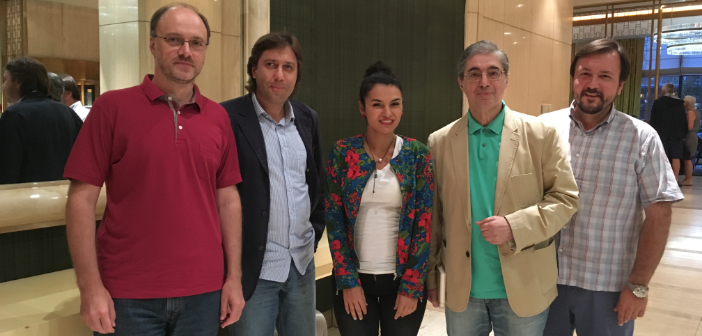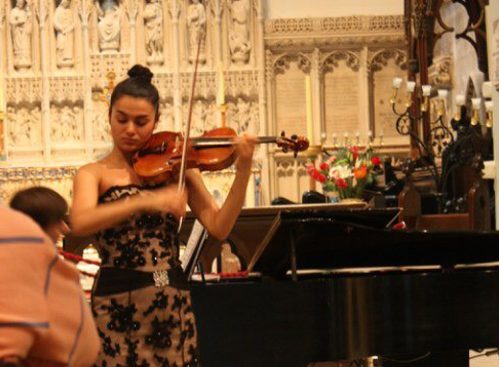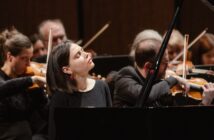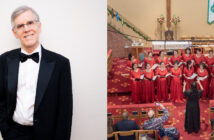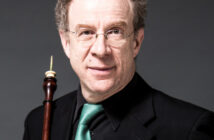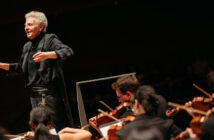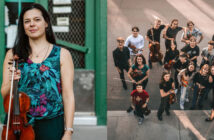To catch all the members of the Borodin Quartet off stage is almost impossible. Formed in 1945, the legendary Russian ensemble, rarely, if ever, gives interviews – especially when they are on tour abroad.
I conducted this interview after their spectacular opening Pollack Hall concert on August 14 at the McGill International String Quartet Academy (MISQA), where they gave masterclasses to quartets from all over the world.
Speaking in Russian, first violinist Ruben Aharonian, second Sergey Limovsky, violist Igor Naidin, and cellist Vladimir Balshin covered a range of subjects at the four-star Omni Hotel in downtown Montreal.
Nuné Melik: The audience was delighted. Were you happy with your performance?
Ruben Aharonian: You know, we all have ears of professionals that are very demanding. We all understand that during a performance some flaws can occur. We call those imperfections “little tails.” They are inevitable and we understand that. However, in principle, we assume that the Sunday concert was a successful one, in principle.
NM: How do you choose programs in general?
Igor Naidin: Usually, it depends on many factors: what would we like to play, what are we preparing for the upcoming season, what they ask us to play.
NM: How did you come up with the Montreal program?
Vladimir Balshin: Since we are a Russian ensemble, we decided to play a program with the spirit of our country. Tchaikovsky’s “Children’s Album” Op. 39 and Borodin’s Quartet No. 2 are very representative of the Russian spirit and great traditions. And the Haydn Quartet [Op. 33, No. 5] was written for Grand Duke Paul of Russia and Grand Duchess Maria Feodorovna.
NM: The “Children’s Album” was something new to me. I recall playing every single piece on the piano, but I have never heard it in a quartet version.
RA: You could not hear it in a quartet version because this arrangement by Rostislav Dubinsky, first violinist until 1976, exists in our archives only. It has never been published and everyone plays by the handwritten copies. Moreover, to read it better, I made my own handwritten copy.
NM: What impressed me the most that you had to unify 25 short pieces into one idea. Is it hard to interpret?
RA: It is. The pieces are very short, and each of them requires extreme concentration and precision, and yet also some finesse.
NM: Speaking about repertoire, is there music you don’t like to perform?
IN: Contemporary music.
SL: By contemporary music, we do not mean Schnittke, the New Vienna School or Shostakovich, of course.
NM: You must be asked all the time: How do you achieve such perfect intonation?
VB: We are constantly listening to how we sound, so that we identify places that require focused work.
IN: And there are places like that in almost every single rehearsal.
RA: However, we don’t spend a specific amount of time every day working just on intonation. Once something doesn’t sound perfectly in tune, we stop and work on it. And then move on.
NM: You are also praised for your impeccable balance. As someone said about you: “One instrument with sixteen strings.” How do you achieve that?
Segey Lomovsky: The same as with the intonation. We work on it while rehearsing and trying to listen to each other.
RA: You see, the balance is the most important feature for a good quartet. It was a landmark of the initial Borodin Quartet. We are trying to keep that tradition. We listen to each other and adjust constantly.
NM: At the same time, watching you at the concert, I had the impression that it was one person playing. You are so well in sync that it seems you don’t need visual cues.
IN: We do look at each other.
RA: Moreover, Igor often asks me to change my place at rehearsals, so he can see all the members of the quartet. Also, we have special markings in our music, at particularly difficult moments, that reminds us show visual cues to the others. We don’t conduct every bar, of course.
IN: And although there is showing going on, there is not much showing off.
NM: When you were students, did you dream of a chamber music career?
RA: I had a busy career as soloist and conductor of the State chamber orchestra of Armenia for 20 years when I received a phone call from Mr. Berlinsky [cellist Valentin Berlinsky, 1945–2007]. The ensemble was searching for a new first violinist after Mr. Kopelman [Mikhail Kopelman, 1976–1996] had emigrated to the United States. I did not sleep for two nights thinking about the offer. But the reputation of the musicians and the Quartet finally made me accept it, and I have never regretted it since.
VB: In my case, I have been playing chamber music as long as I can remember. My ultimate love for the chamber music played the most important role in choosing this path.
IN: I started out as a violinist before switching to the viola. I was coached by members of the Borodin Quartet, particularly Mr. Kopelman and Mr. Berlinsky. Mr. Shebalin [Dmitri Shebalin, 1953–1996] was my viola professor, and so the musical philosophy of the Quartet became the only one for me.
NM: Sergey, you were the last one to joining the Quartet in 2011, replacing a violinist who played there for 38 years.
SL: You know, I had always wanted to play in a quartet but never had time for it. Joining the Borodin Quartet was therefore a dream come true. Once the offer was made, I could not be happier and did not hesitate for a second.
RA: Nevertheless, the artistic director of the chamber orchestra where Sergei worked, Mr. Yuri Bashmet, wanted to keep such a major musician in his ensemble and it was not easy for him to let Sergei go.
NM: You often play piano quintets. Are there musicians that you haven’t performed with yet but really would love to?
RA: We are lucky to perform with first class musicians, including winners of the Tchaikovsky Competition like John Lill, Vladimir Krainev, Denis Matsuev, and Boris Berezovsky, and we have just played with Dmitry Masleev, the 2015 winner.
NM: Who are the musicians of the past that you would have loved to play with?
RA: The Quartet collaborated with the legendary pianist Sviatoslav Richter for a long time. Unfortunately, none of us had a chance to play with him. The BQ also had a fruitful collaboration with Emil Gilels, though for a shorter time. I would have loved to play with those legends. And also the C Major Quintet of Schubert with cellist Sviatoslav Knushevitsky.
VB: Again, so hard to come up with one name, even from the past… Possibly, for me it would be pianist Leo Oborin.
NM: What do you think distinguishes you from other quartets?
IN: It is hard to judge ourselves, really.
VB: I think, most importantly, is that we keep playing in an academic manner…
RA: Perhaps also, as it was mentioned before: we are minimalists when it comes to visual effects. Sometimes, we are even criticized for that.
NM: Generally speaking, how playing developed over the years?
SL: Towards more communication with each other using visual cues and body language. Some of the ensembles keep the traditions of the minimal moving during the performance. For instance, the Alban Berg Quartet – they have an incredible quality of playing while almost no visual excitements…
RA: As well as the Amadeus Quartet. They developed their unique style of intellectual playing without help of body language.
NM: You are considered the best interpretator of the chamber music of Shostakovich and Borodin. You are also famous for your recordings of the late quartets of Beethoven. Would you like those to be more of what you’re recognized for?
IN: We have had meaningful relationships and a long history with Beethoven since 1945 – there is a long history connecting the music of this composer and our quartet. We are also often invited to play his masterpieces, which we enjoy. That is where our mention above of “one instrument with 16 strings” came from.
NM: Do you have some special rituals and routines before the performance?
IG: We rehearse one hour, on the day of every concert. And we require that there be only 30 minutes gap between the end of our rehearsal and the beginning of the concert.
RA: We are very particular about it, and often fought with organizers over for this ritual.
NM: After more than 6000 concerts, are there places left where you haven’t performed yet?
SL: We are getting closer to 7000 concerts, actually. There might be only Africa left.
NM: What about Hawaii?
RA: We have performed there. At the Honolulu University, in the sixties…
NM: Do you prefer recording or live performances?
SL: We love doing both. Each of these forms has its advantages.
IN: However, as a quartet, we’d prefer the live performances.
NM: What highlights of this season are you looking forward to?
RA: For us, it is always a special occasion to play at Wigmore Hall. It has an almost perfect acoustics for the chamber music.
VB: Speaking about the halls, the hall in Bilbao is one of extreme beauty and great acoustics.
NM: Last question: if you had the only one recording for future generations, which one would it be?
RA: It is our current recording of all of the quartets of Dmitriy Shostakovich, which is almost complete… I might take the courage to say, that the recording of the quartets of No. 14 and 8 are pretty good. I think that we were able to convey the composer’s message for future generations to its full extent.
Updated September 14, 2016

